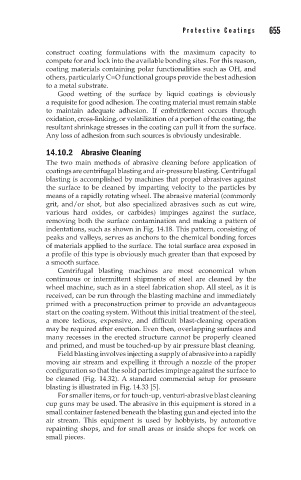Page 701 - Corrosion Engineering Principles and Practice
P. 701
654 C h a p t e r 1 4 P r o t e c t i v e C o a t i n g s 655
construct coating formulations with the maximum capacity to
compete for and lock into the available bonding sites. For this reason,
coating materials containing polar functionalities such as OH, and
others, particularly C=O functional groups provide the best adhesion
to a metal substrate.
Good wetting of the surface by liquid coatings is obviously
a requisite for good adhesion. The coating material must remain stable
to maintain adequate adhesion. If embrittlement occurs through
oxidation, cross-linking, or volatilization of a portion of the coating, the
resultant shrinkage stresses in the coating can pull it from the surface.
Any loss of adhesion from such sources is obviously undesirable.
14.10.2 Abrasive Cleaning
The two main methods of abrasive cleaning before application of
coatings are centrifugal blasting and air-pressure blasting. Centrifugal
blasting is accomplished by machines that propel abrasives against
the surface to be cleaned by imparting velocity to the particles by
means of a rapidly rotating wheel. The abrasive material (commonly
grit, and/or shot, but also specialized abrasives such as cut wire,
various hard oxides, or carbides) impinges against the surface,
removing both the surface contamination and making a pattern of
indentations, such as shown in Fig. 14.18. This pattern, consisting of
peaks and valleys, serves as anchors to the chemical bonding forces
of materials applied to the surface. The total surface area exposed in
a profile of this type is obviously much greater than that exposed by
a smooth surface.
Centrifugal blasting machines are most economical when
continuous or intermittent shipments of steel are cleaned by the
wheel machine, such as in a steel fabrication shop. All steel, as it is
received, can be run through the blasting machine and immediately
primed with a preconstruction primer to provide an advantageous
start on the coating system. Without this initial treatment of the steel,
a more tedious, expensive, and difficult blast-cleaning operation
may be required after erection. Even then, overlapping surfaces and
many recesses in the erected structure cannot be properly cleaned
and primed, and must be touched-up by air pressure blast cleaning.
Field blasting involves injecting a supply of abrasive into a rapidly
moving air stream and expelling it through a nozzle of the proper
configuration so that the solid particles impinge against the surface to
be cleaned (Fig. 14.32). A standard commercial setup for pressure
blasting is illustrated in Fig. 14.33 [5].
For smaller items, or for touch-up, venturi-abrasive blast cleaning
cup guns may be used. The abrasive in this equipment is stored in a
small container fastened beneath the blasting gun and ejected into the
air stream. This equipment is used by hobbyists, by automotive
repainting shops, and for small areas or inside shops for work on
small pieces.

